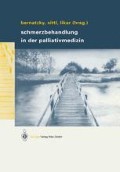Zusammenfassung
Die Zahl der Tumorerkrankungen in Österreich steigt. Bei den Männern waren in Österreich im Jahr 1999 Krebserkrankungen bei 26,7% aller Todesfälle verantwortlich, bei den Frauen war der Anteil 21,5%. Die Zahl der Krebserkrankungen wird unabhängig vom Krebsrisiko in der Bevölkerung — allein aufgrund der Entwicklung der Alterspyramide in den nächsten Jahrzehnten noch zunehmen. Erst etwa ab dem Jahr 2030 wird die Zahl der Krebserkrankungen wieder abnehmen.
Access this chapter
Tax calculation will be finalised at checkout
Purchases are for personal use only
Preview
Unable to display preview. Download preview PDF.
Literatur
Broer H, Schnürisch HG (1997) Beitrag der Anästhesiologie zur onkologischen Schmerztherapie. Gynäkologe 30: 864–874
Hankemeier et al (2000) Tumorschmerztherapie. Springer, Berlin Heidelberg New York Tokyo
Hankop GG et al (2000) Schmerztherapie in der Palliativmedizin. Internist 41: 633–640
Heidemann E (1999) Tumorpatienten in Deutschland: Was wissen wir über Schmerzprävalenzen? Schmerz 13: 249–252
Krebshilfe (Hrsg) (2001) Konsensus Statement, Tumorschmerz, Interdisziplinäres Management
Leitlinien zur Tumorschmerztherapie (1999) Tumordiagnostik und Therapie 20: 105–128
Sittl R et al. (2000) Schmerztherapie beim metastasierten Mammakarzinom. Diagnostik und Therapie des Mammakarzinoms - State of the Art. W. Zuckschwerdt Verlag, München
WHO (1996) Cancer pain relief, 2nd edition; with a guide to opioid availability. World Health Organization, Geneva
Pipam W, Likar R, Mocker J, Bernatzky G, Platz T, Sittl R, Janig H (2002) Ergebnisse einer Umfrage zu Schmerzen und Lebensqualität bei Tumorpatienten. Schmerz 16: 481–489
Baldwin GC, Tashkin DP, Buckley DM, Park AN, Dubinett SM, Roth MD (1997) Habitual smoking of marijuana and cocaine impairs alveolar macrophage function and cytokine production. J Resp Crit Care Med 156: 1606–1613
Beal JA (1994) Appetite effect of dronabinol. J Clin Oncol 12: 1524–1525
Campbell FA, Tramèr MR Carroll D, Reynolds DJ, Moore RA, McQuay HJ (2001) Are cannabinoids an effective and safe treatment option in the management of pain? A qualitative and systematic review. BMJ 323: 13–16
Jatoi A, Windschitl HE, Loprinzi CL, Sloan JA, Dakhil SR, Mailliard JA, Pundaleeka S, Kardinal CG, Fitch TR, Krook JE, Novotny PJ, Chistensen B (2002) Dronabinol versus megestrol acetate versus combination therapy for cancer-associated anorexia: a North Central Cancer Treatment Group study. J Clin Oncol 20: 567–573
Kalso E (2001) Cannabinoids for pain and nausea. BMJ 323: 2–3
Marsicano G, Wotjak CT, Azad SC, Bisogno T, Rammes G, Cascio MG, Hermann H, Tang J, Hofmann C, Zieglgänsberger W, DiMarzo V, Lutz B (2002) The endogenous cannabinoid system controls extinction of aversive memories. Nature 418: 530–534
Mechoulam R, Hanu L (2001) The cannabinoids: an overview. Therapeutic implications in vomiting and nausea after cancer chemotherapy, in appetite promotion, in multiple sclerosis and in neuroprotection. Pain Res Manag 6: 67–73
Reynolds R (2002) Comparative efficacy of dronabinol and megestrol acetate. J Clin Oncol 20: 2912–2913
Smith PF (2002) Cannabinoids in the treatment of pain and spasticity in multiple sclerosis. Curr Opin Investig Drugs 3: 859–864
Tashkin DP, Baldwin GC, Sarafian T, Dubinett S, Roth MD (2002) Respiratory and immunologic consequences of marijuana smoking. J Clin Pharmacol 42: 71–81
Timpone JG, Wright DJ, Li N, Egorin MJ, Enama ME, Mayers J, Galetto G (1997) The safety and pharmacokinetics of single-agent and combination therapy with megestrol acetate and dronabinol for the tratment of HIV wasting syndrome. Aids Res Human Retroviruses 13: 305–315
Tramer MR, Carroll D, Campbell FA, Reynolds DJ, Moore RA, McQuay HJ (2001) Cannabinoids for control of chemotherapy induced nausea and vomiting: quantitative systematic review. BMJ 323: 16–21
Walker JM, Huang SM (2002) Cannabinoid analgesia. Pharmacol Ther 95: 127–135
Collins JJ, Grier HE, Kinney HC, Brede CB (1995) Control of severe pain in children with terminal malignancy. J Petiatr 126: 653–657
Griessinger N, Rösch W, Schott G, Sittl R (1997) Tramalinfusion zur Schmerztherapie nach großen Blaseneingriffen auf Kinderstationen. Urologe 36: 552–556
Häberle H, Niethammer D (1995) Leben will ich jeden Tag. Leben mit krebskranken Kindern und Jugendlichen - Erfahrungen und Hilfen. Herder, Freiburg Basel Wien
Hanekop G-G, Sorge J, Aulbert E et al. Anleitung zur Tumorschmerztherapie bei Kindern und Jugendlichen. Arbeitskreis „Tumorschmerz“ der DGSS (erhältlich bei Grünenthal GmbH, 52220 Stolberg)
Kart T, Christrup LL, Rasmussen M (1997) Recommended use of morphin in neonates, infants and children based on literature review: Part 2–Clinical use. Paediatr Anaesth 7: 93–101
McGarth PA (1996) Development of the World Health Organization guidelines on cancer pain relief and palliative care in children. J Pain Symptom Manage 12: 87–92
Pothmann R (1996) Besonderheiten des akuten Schmerzes im Kindesalter. Der Schmerz 10: 1–13
Sittl R (1998) Wie behandelt man Krebsschmerzen bei Kindern und Jugendlichen? In: Jage J (Hrsg), Medikamente gegen Krebsschmerzen, 3. Aufl. Chapman and Hall, London, S 230–239
Zernikow B, Griessinger N, Fengler R (2000) Praktische Schmerztherapie in der Kinderonkologie. Schmerz 13: 213–235
Editor information
Editors and Affiliations
Rights and permissions
Copyright information
© 2004 Springer-Verlag Wien
About this chapter
Cite this chapter
Likar, R. (2004). Therapie — nicht invasive Möglichkeiten: medikamentöse Methoden. In: Bernatzky, G., Sittl, R., Likar, R. (eds) Schmerzbehandlung in der Palliativmedizin. Springer, Vienna. https://doi.org/10.1007/978-3-7091-3811-3_8
Download citation
DOI: https://doi.org/10.1007/978-3-7091-3811-3_8
Publisher Name: Springer, Vienna
Print ISBN: 978-3-211-83883-9
Online ISBN: 978-3-7091-3811-3
eBook Packages: Springer Book Archive

